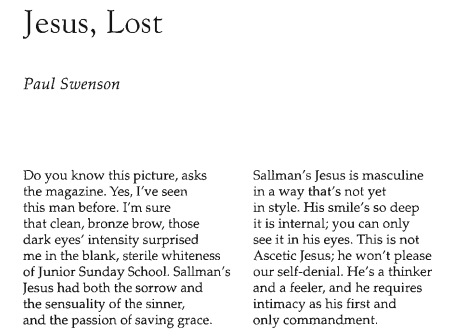Articles/Essays – Volume 32, No. 4
Jesus Lost
[Editor’s Note: The table is utilized to replicate the formatting of the PDF below]
| Do you know this picture, asks the magazine. Yes, I’ve seen this man before. I’m sure that clean, bronze brow, those dark eyes’ intensity surprised me in the blank, sterile whiteness of Junior Sunday School. Sallman’s Jesus had both the sorrow and the sensuality of the sinner, and the passion of saving grace. | Sallman’s Jesus is masculine in a way that’s not yet in style. His smile’s so deep it is internal; you can only see it in his eyes. This is not Ascetic Jesus; he won’t please our self-denial. He’s a thinker and a feeler, and he requires intimacy as his first and only commandment. |
| He’s the Jesus of my childhood but he’s lost now. They’re looking for him, the advertisement says. Or, looking for someone who remembers where he hung, at home, or school or church, or if (still) sometimes at night, he lurches in their hearts. | Why is Jesus lost? They didn’t ask that question on Good Friday, or the Day of Pentecost. But in the latter day, we just don’t know. We cannot seem to find him. Once saw his name and image on a poster—wanted for anarchy, sedition, vagrancy, conspiracy to overthrow. |
| The Jesus on Channel 3 has red hair and cocked eyebrow. He’s both sad and sardonic, yet ain’t it more than a little ironic that he’s more real than Judge Judy or Geraldo? I like it when he shares the screen with Dragon Lady, who wears a huge hive of dark hair with a lightning streak, and a face so soft that the lines in it look like rivers. | I look for Jesus in the faces of the children in a sixth-grade class. That dark-eyed one with bangs and freckles; her look of reckless tenderness. But I’m confessing that I haven’t found him —not completely. The ad says scholars want to study him; perhaps they miss his lost caress. Should he arrive, should you find him, copy this address: Valparaiso, Indiana, Box 55. |


 Back to full Issue
Back to full Issue

